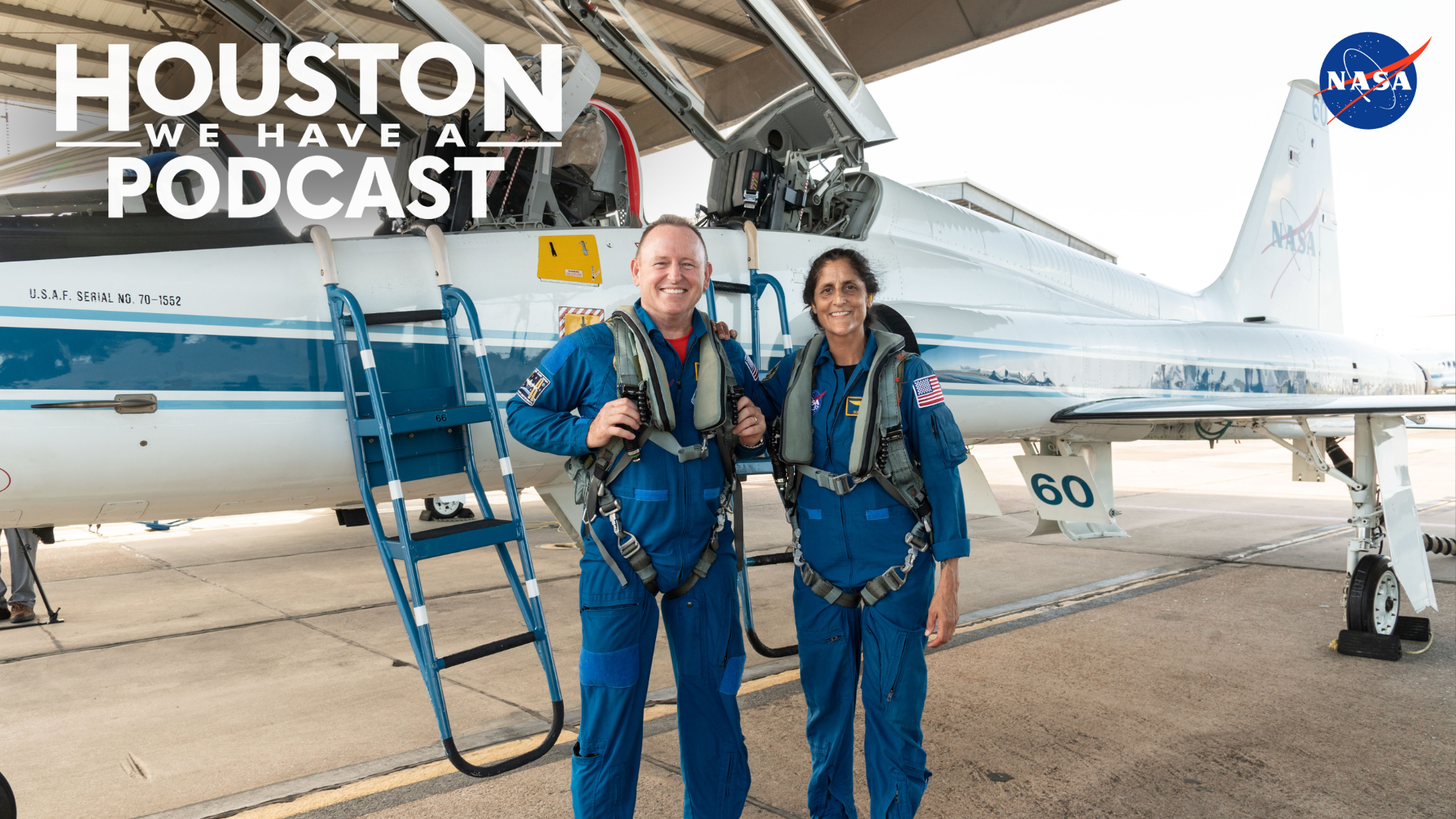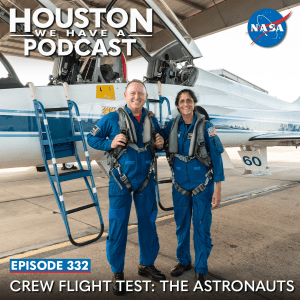
From Earth orbit to the Moon and Mars, explore the world of human spaceflight with NASA each week on the official podcast of the Johnson Space Center in Houston, Texas. Listen to in-depth conversations with the astronauts, scientists and engineers who make it possible.
On episode 332, NASA’s Boeing Crew Flight Test Commander Butch Wilmore and Pilot Suni Williams discuss their astronaut journeys and preparation to be the first humans to fly Starliner. This episode was recorded on March 13, 2024.

Transcript
Gary Jordan: Houston, we have a podcast! Welcome to the official podcast of the NASA Johnson Space Center, Episode 332, “Crew Flight Test: The Astronauts.” I’m Gary Jordan, and I’ll be kicking off this episode today. On this podcast, we bring in the experts, scientists, engineers, and astronauts, all to let you know what’s going on in the world of human spaceflight and more. And once again, I’m very proud to welcome yet another talented individual and her voice as a host of the podcast, Courtney Beasley. Courtney, welcome.
Courtney Beasley: Hi, I’m so happy to be here and happy to join the podcast team.
Gary Jordan: I’m happy you’re the one doing this episode because your role is working with astronauts. Can you expand a little bit about what you do?
Courtney Beasley: Yeah, so I am the team lead for the Flight Operations Directorate, or FOD. Basically, we get the opportunity to work with astronauts to help with their public affairs, appearances, and we also get to work with the crew out at Ellington for some of those flight operations. We also have the opportunity to work with the Mission Control teams with the flight directors and flight controllers. So it’s just overall a really, really cool beat to be part of here at NASA because we get to really represent kind of the faces of the agency.
Gary Jordan: Very much so. I think being here and doing this opening episode for you with Butch and Suni, not a bad way to start. They had a lot of energy in this interview.
Courtney Beasley: They did. A lot of personality, a lot of excitement. I think it was just really cool to catch up with them and see how excited they are because I know that the world and the nation is just so excited for them.
Gary Jordan: Wonderful. And I’m so thankful that you did this. Are you ready to get started?
Courtney Beasley: I’m ready. Let’s go.
Gary Jordan: Alright, let’s do it.
Host (Courtney Beasley): We are right around the corner from the first flight of the Boeing Starliner with humans on board. The mission: the Crew Flight Test. It’s been a long journey to get to this point and the teams are ready to fly. None more so than the astronauts who have been training and preparing for this historic moment, Commander Butch Wilmore and Pilot Suni Williams.
Butch and Suni are the perfect pair to be the first to launch aboard Starliner. Both are seasoned Navy test pilots, as well as seasoned astronauts. Both have flown to the International Space Station twice before, once on a space shuttle and once on a Russian Soyuz. And the Boeing Starliner will be the third spacecraft for each of them to take to the station. They have both stayed aboard the station for a long duration Expedition, Suni doing so twice, and Butch serving as a station commander during his Expedition. And both have performed spacewalks. Since their last spaceflights, they have been assisting NASA’s Commercial Crew Program and Boeing on the design and development of the Starliner spacecraft.
Originally from Tennessee, Butch Wilmore received a bachelor’s and master’s in electrical engineering from Tennessee Technological University, as well as a master’s in aviation systems from the University of Tennessee. During his time in the Navy, Butch accumulated 8,000 flight hours in tactical jet aircraft. He completed four operations deployments, and he’s also a graduate of the U.S. Naval Test Pilot School. During his time as a test pilot, he participated in all aspects of the initial development of the T-45 jet trainer and served as a systems and fixed-wing flight test instructor. Butch remains active in the United States Navy as a captain. He was selected by NASA as an astronaut in 2000. In 2009, he flew as the orbiter pilot for STS-129 for a mission to the station, delivering express logistics carriers and 30,000 pounds of replacement parts for station. In 2014, he flew aboard the Russian Soyuz to the station for a 167-day mission. And during that time, he served as station commander.
Born in Ohio, but considers Needham, Massachusetts to be her hometown, Suni has a bachelor’s in physical science from the U.S. Naval Academy and a Master of Science in engineering management from the Florida Institute of Technology. During her time in the Navy, Suni accumulated more than 3,000 flight hours in over 30 different aircraft, mostly helicopters. As a naval aviator, she was deployed overseas and served in leadership roles before being selected for U.S. Naval Test Pilot School. As a test pilot, she flew a variety of helicopters and served as a rotary wing instructor. She was selected as an astronaut in 1998 and flew two long duration Expeditions to the station. In 2006, she launched on the STS-116 and returned aboard STS-117 in 2007. And in 2012, she flew aboard a Russian Soyuz for another stay aboard station. Over the course of her two spaceflights, she accumulated seven total spacewalks at 50 hours and 40 minutes.
Despite these accolades, they are both incredibly humble and wonderful individuals who are very much looking forward to this historic flight. I was lucky enough to snag them both at the same time for a chat about their journey to get us to this point. So here’s Butch Wilmore and Suni Williams ahead of their flight aboard the Boeing Starliner. Enjoy.
[Music]
Host: Alright, well, Butch and Suni, hello to you both and welcome to Houston We Have a Podcast.
Butch Wilmore: Good morning.
Suni Williams: Super psyched to be here.
Host: We’re excited to have you. So we want to start by talking about the Starliner spacecraft. What makes this spacecraft special to the both of you?
Suni Williams: So, you know, I think the most special part is it’s the first time it’s going to be flown—so that’s pretty cool—with people on it. So that makes it really special. And we’ve had a hand in developing all sorts of parts of it, from procedures to hardware to software, you know, the whole kit and caboodle with our many people on our many teams. I think seeing it all come together is really, really, really special. And hopefully, you know, knock on wood, being successful and going up, coming back down and handing the spacecraft back to the company and saying “You’re ready to put people on it,” is pretty, pretty awesome.
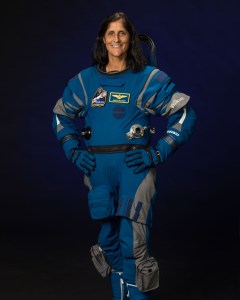
Butch Wilmore: Yeah, I would agree. I mean, the opportunity for a first flight of a spacecraft comes around only so often. This is the sixth in the history of NASA’s Human Spaceflight Program, and to take part in this and the progression from the early years—Suni’s been at it longer than me—but early years to where we are now on the cusp of launching and all the work that comes into that development. Like she said, our hands in every procedure, some alterations to hardware and software, and be a part of that process, and then actually get to climb up and ride that elevator up to the top level and climb on board, wow. Yeah. It’s amazing. Very thankful.
Host: You both had the opportunity to fly shuttle as well. Do you see any similarities or differences that you would want to talk about?
Butch Wilmore: Similarities. There are a few. You know, I get asked, “Hey, when do you fly the shuttle?” I still get asked that, well, the shuttle was a lifting body, right? And the only way it could land was on a runway. So we have the capability now that we are flying capsules. We only have capsules now. Throughout the globe, we’re only flying capsules. There are no human-rated lifting bodies anymore. We’re going to land on land, but we could also land in the water. And, you know, the Soyuz lands on land, the SpaceX lands in water, it is its primary. So it gives us that capability and that flexibility depending on what regime of flight we might be in or might find ourselves in. So it’s not shuttle-like in any respect other than it has a crew module that is pressurized that can go into the vacuum of space, and that’s about where the similarities end as far as capabilities that all go.
Suni Williams: Yeah. But I think one other similarity just is the heritage of the shuttle, right? And the history that they’ve built this spacecraft on. It’s funny because the cockpit looks a lot different, but it also looks a little similar. You know, of course things are modernized. We have maybe a 10th of the amount of switches that the shuttle cockpit had, but the philosophy and that rigor of how the space shuttle was designed and operated, I feel that in this spacecraft as well, you know, if not through the people, but through how we chose to design it and actually operate it.
Host: You talked a little bit about history, you two are both at the beginning of history for this spacecraft. When you get home at night and get to really sit back and think about that, what does that feel like to you?
Butch Wilmore: I don’t have time to think on that, but my wife has me busy when I get home. It’s a great question and it’s a fair question. You know, you pinch yourself and you say, “Hey, really the first flight of a spacecraft and all this that we’ve had the opportunity to take part in,” you know, you think, Lord, why me? Of all the people that have been here, this is where it’s me and it’s Suni and it’s us. And it is a little awe-inspiring and it’s very humbling when you think about everybody else that could be here and for whatever reason, the good Lord’s got you here. And it’s a humbling thought. It truly is.
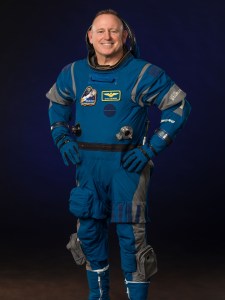
Suni Williams: And honestly, I hesitated as well too because I think on a daily basis, you know, I don’t think either one of us, or probably any of our team really think about that. You know, we’ve got a mission to do. So we are sort of laser-focused on making sure everything, the T’s are crossed and the I’s are dotted. But then again, like Butch said, when you back away from it and you know, you go and talk to people who are not really in it and they understand, they know that you’re going to be flying on the first spacecraft, then you sort of go like, “Oh, wow. It’s really cool, actually. It’s pretty awesome.”
Host: Well, we are certainly proud of the two of you and all of the teams behind it. This is so exciting. And you’re both experienced test pilots and astronauts, and I’m sure that that has gone a long way in the design of the spacecraft. How has your experience as a pilot helped in the design process and the feedback that you’ve been able to give them?
Butch Wilmore: Yeah, there is a difference and it’s a good difference. I can’t go in and help some of the designers of software. I can’t help some of the designers of hardware. So the engineers that do those things, they have a certain gift and a certain capability that I don’t understand how to alter those things. But on the other respect, as operators, which is what we are, they’ll go do a test in a test facility we have, the engineers will do that, and they’ll go through the process of effecting whatever this test is from start to finish. And they’ll say, “It looks good.” And we’ll come in as the operators and we’ll say, “Oh yeah, that’s not right. That’s not right, we need to change that. That’s way not right.” And that’s what the experience brings to the table, that test pilot checking everything all the way down to what’s the firmware in that box? What are we testing? Is that the right firmware? You know, those type of questions that some people wouldn’t even think to ask. So we’ve seen that and we would expect to see that because that’s our role. Yeah, that’s what we’ve been trained for.
Suni Williams: I mean, it’s a monumental project, right? So there’s a lot of people who are, you know, focused on one part of their spacecraft, and we have the luxury with our control team to see it integrated and put all together. And sometimes that could be an area of concern because that integration doesn’t get done before we get the product and we get to test it all out, right? So how everything works together is something that us, as the end user, get to test and ask about. And don’t assume just because it is specifically because it is the first time we’re putting humans on there, don’t assume everything is absolutely right. If something doesn’t seem right, ask the question. And Butch is awesome about doing that. You know, like if he sees something that just doesn’t, you know, sound right, or the timing on that doesn’t look right, he will ask the question right away. We will dig into it, and we’ll find out whether or not it’s supposed to work that way or wow, that that might be a little problem and we’ve got to fix that.
Butch Wilmore: Yeah. Integration’s the main thing. She’s right. You know, if you think about a pyramid, the tip of the pyramid, the top, is where the operators come together, and that integrated product comes together. That box with its software, that hardware box with its software, has been tested ad nauseum in this hardware box, and that software has been tested ad nauseum, and you put them together and something usually is not perfect. And that’s our job to find out where those little deficiencies are and rectify them.
Host: I want to talk to you both about life as a pilot. Can you take me back to some of your first memories of just being interested in flying, whether as a pilot or astronaut?
Suni Williams: Nostalgia. Yeah, sure. Being a pilot wasn’t actually my first choice as a career in the Navy. I actually wanted to be a diver. But Top Gun came out and I saw how cool Tom Cruise was, and I wanted to be a jet pilot, so I went to flight school. Anyway, there, like I said, I wanted to be a jet pilot, but I came a helicopter pilot and I loved it from the first time I started.
Butch Wilmore: I like Iceman. I like his hair. Sorry.
[Laughs]
Suni Williams: The first time I got in a helicopter, I was like, “Wow, this is fun.” You know, you just pick off the ground and you’re just sort of flying around like at like two feet off the ground. And, you know, learning how to fly was awesome, of course. And then the latter part of it, being a test pilot as a helicopter pilot was just incredible. I had so many great classmates in my test pilot school class from all over the world who are extremely awesome pilots who could take a helicopter with a skid and, you know, pick up a pale of sand with them. They were so awesome and precise. And everything that we did at test pilot school was amazing to understand exactly how helicopters work. And that’s where like my engineering brain kicked in and I was like, “Oh, I love this.”
I’ve scared myself in a helicopter before doing test points, you know, new rotor heads, new engines, putting inputs in that were a little surprising, which is what we do in a stepwise process to get to a point that, hey, you know, maybe that’s enough. We did something called an HV diagram where you find out where the limits are for doing auto rotations. I was instructing in that curriculum. And it’s nerve wracking, when you’re doing some of that type of stuff, but it’s really rewarding because you’ve done the research beforehand, you know pretty much how things are going supposed to go. So when you have those little surprises, you know how to back off and get yourself out of those situations. So I love, love, love flying helicopters. I love flying the T-38 with Butch. It’s also a lot of fun. You know, we can do little test points with that aircraft, too, like flying fast and then trying to figure out the distance of how, if you pull the throttles back, how far it will take to slow down to a certain speed. It’s fun. Just like trying things out with aircraft. Aircraft or helicopters.
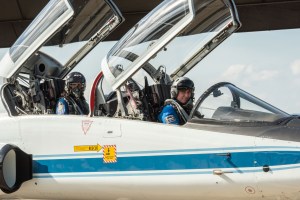
Butch Wilmore: Yeah. And test pilot school. There’s a fixed-wing program, a systems program, and a helicopter program. And we have some classes together, some of the basic classes, but large part of the year, you’re separated and they’re Helo guys, folks are off doing their thing. And then the hardest curriculum, probably the hardest curriculum, but I always wondered what they did, so now I know they’re out picking up pales of sand. That’s good to know.
[Laughs]
Suni Williams: Precisely flying.
Butch Wilmore: Oh, okay. Precisely. Yeah.
Host: Yeah. What about you, Butch? What are some of your first memories you have of being interested in flying?
Butch Wilmore: You know, my mom said my first word was not “mom” or “dad.” It was “why?” I was always questioning everything. And I think what does it look like from up?
Suni Williams: They wanted to kill you probably.
Butch Wilmore: They did. And I don’t blame them, you know, what does it look like from up there? How make the airplane do that? How do you make it climb and descend? And that was the initial thoughts for me. Just the basic, you know, “Hey, yeah, I want to see what it looks like.” Then from there, once I got into the Navy and started flying, I’m like, “Wow, I’d like to know more about how these flying machines operate and get into the nitty gritty.” The engineer side of me took over, and so that’s why I started making application to test pilot school. And then once that was done, I had finished a master’s degree or two, and then I thought, “Wow, you can’t fly any higher and faster than the shuttle. I wonder what it looks like from way up there.” So made application to NASA and they said, “Thank you very much, appreciate your application.” And then I made another one a couple of years later and they said, “Oh, that was nice, thank you for your application.” They were very cordial. And then the third time I applied, they actually called me for an interview, and I came down. Didn’t select me though, and I thought, “Okay, I’ll get one more shot.” So I did, and here we are. Great evolution. Learned a lot.
Host: Well, we’re glad. Glad you went for a fourth time. We’re glad you’re here. Suni, you mentioned briefly about being an instructor, and both of you had the opportunity to do that. What were some lessons you passed to your students?
Suni Williams: I think the biggest thing is be diligent and be intentional in all of the thought process and testing that you’re going to do. Don’t go out there and be a cowboy. I mean, that’s not how we work here. It’s not really how testers work in the real world, even though I think there could be some reputation about that. It’s not without the engineering rigor to understand what’s going on before you actually take that step into the cockpit. So, I think that was the biggest thing. Know what’s going to happen and have a backup plan. I think that was another one of the biggest things to test pilot school that I understood you always have a backup plan. You can’t just go out there and wing it. You need to know what you’re going to do to come back home.
Butch Wilmore: Yeah. You know, there’s various modes of flight test. And I think the thing you would want to teach someone is, you know, there’s an envelope that we operate in safely, but as testers, we go beyond the envelope to see how close, because trust me, the fleet folks, they’re going to go outside the envelope eventually. Well, how do they get out of those situations where they go beyond, where the aircraft actually flies well? And that’s what flight testers do, and in certain respects is we figure out where those are. I know for helicopter folks, one of the things I do know they do, other than picking up sand, is that they would go high altitude and they would test how high you can go in a helicopter. I mean, you’re beating the air into submission. That’s what folks do, right?
Suni Williams: There’s not much air up way high.
Butch Wilmore: Yeah, not a lot of air up there. So they do that and they test the ends of the envelope, and that’s what we do. And we do that, and you’ve got to be very careful. You need to know your spacecraft, your aircraft well, when you’re going to those regimes of flight, and you need to understand what it tells you. When you’re doing flutter tests, I mean flutter literally, the wings are fluttering. That’s what flutter test is. You’re outside the operational bounds of the aircraft and also even the aircraft carrier. You know, I took the T-45 to the ship for the first time, and you set the minimum end speed, the least amount of air over the deck of which you would launch, and where the aircraft actually settled 20 feet off the bound. I got a story about that, I won’t tell it now. But doing that and knowing how to do that, because you can be in the water really quick, if you’re not stepping up so professional, listen to your engineers. They actually do know what they’re talking about in most cases and understand every aspect of the aircraft that you can for the flight regime that you’re looking at.
Host: Suni, you had the opportunity to join the Commercial Crew cadre in 2015, so you’ve probably had the opportunity to teach and to learn a little bit. What has it been like to see where it was in 2015 and where it is today?
Suni Williams: Yeah, it’s amazing. You know, I think there was a lot of doubt actually even a little bit before 2015, as we started doing some commercialization of space with our other partners, bringing up tourists, right? So it was like, what the heck is this? And then we took it and ran with it with the Commercial Crew Program. I think there was probably a little bit of doubt, like, how are these companies really going to do this on their own? You know, I can’t imagine how this is going to happen. We, you know, NASA of course, has the Commercial Crew Program to provide a little bit of oversight, but the requirements were pretty vague to allow the companies to figure out all these things on their own. So they would incorporate creative new ideas and technologies in the way they did it. But there was a lot of doubt, right? And now to see our spacecraft ready to go is pretty amazing.
I mean, we are ready, it is ready, the team is ready. To also see our other partners, SpaceX, you know, launching people to the International Space Station is pretty awesome. So it does happen when somebody had a great idea, a couple, I mean, a number of people obviously had a great idea to incorporate this into supplement. Our space exploration allows NASA to really do the exploration onto Moon and Mars and to take over low Earth orbit. And it’s successful and it’s innovative. There’s lots of new technologies and ingenuity to making it happen. It’s different than how we’ve done it before, but that’s okay. It’s the next steps, and it’s getting more and more people to space. So it’s been an evolution, but honestly, when you think about it, it’s since I joined less than a decade. So these are huge steps we’ve taken in 10 years.
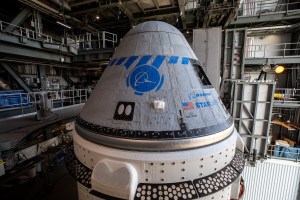
Butch Wilmore: I’ve got just a little example. So a black zone is a part of the flight envelope, part of the flight profile, that if something specific things happen is not survivable, you can’t survive. And we had several black zones on entry coming back into landing. Through the evolution of test and recommendation for capabilities within the spacecraft, some software changes and enhancements, we have no black zones at all in Starliner. And that’s the evolution of what we bring to this. It was accepted because how do you fix it if you lose this system, how do you land inside that four-kilometer circle in the White Sands Desert when there’s mountains all around, if you lose certain systems, we go into this backup mode. You’ve got no guidance to hit the point. So you’re going to land in a mountain and you’re probably not going to survive. So we had that, and they were accepted, and we said, “I don’t think we need to accept those because we’ve got the capability.” We can pull the data off of the thing we call a SIGI. It’s our GPS INS type of a type of a box, and we’ve got several of them, and we can put that information directly on one of our displays, and now we don’t have to have a black zone anymore. So that’s kind of the evolution of flight test and understanding your spacecraft and building, taking capabilities that are there and using them to your advantage.
Suni Williams: A big difference from when we were flying shuttle. Shuttle definitely had some black zones. And so this Commercial Crew Program has been a step up and we’re looking forward to opening it further.
Host: Yeah, it’s definitely come a long way. So let’s go ahead and dive into the mission itself. Can you just give us a brief overview of what the Crew Flight Test is?
Butch Wilmore: We’re taking the spacecraft from launch on the pad and going through all the regimes of flight that it will encounter throughout its missions. Now, it may go into other missions, but for the specifically what NASA’s going to use it from for is to and from space station crew and cargo. And we’re going to take it through the ringer on all aspects of that. As soon as we get off the launch rocket, the Atlas V, we’ve got some tests that were incorporated into the flight plan to ensure that the capabilities as designed, function as designed. And we’ll do that all the way up to space station until we dock. And once we dock, go ahead.
Suni Williams: Once we dock, we have all sorts of stuff to do also, because we want to prove that this spacecraft can be shut down entirely and then started back up. But in the meantime, also, we’d like to make sure that it is a “safe haven.” You know, the space station has a couple little things that, you know, emergencies, that it could encounter at some point in time, like a fire or a depressurization. And our spacecraft are lifeboats. So just like the Soyuz and the Dragon and Starliner, they’ll be connected to the space station. If we have any problems, we can always go to our lifeboat to get away from the space station. So we want to prove that out to make sure when we send the next group, four people up to the space station, they can rely on their lifeboat.
So we’ll be checking it out, making sure everything inside works. We’ll be closing the hatch, and, you know, just making sure that that is the safe haven. And the lifeboat will be pre-prepared and ready to go. We won’t go at that time. We’ll open the hatch back up again. We have other tests to do just for cargo and making sure that data can be transferred from the space station to the spacecraft before we get ready to undock and then come home. And we got a bunch of tests on the way home as well.
Butch Wilmore: There’s one set of controls that’s only in the left seat, and we’re both test pilots. And if it’s just me doing it all, and it’s one opinion of one, right? A data point of one person. So because we can, on the way up, we’re going to swap seats and Suni’s going to get in the left seat, and she’s going to do some of the manual flying as well to get her experience. And maybe she sees something or notices something I don’t, because that happens all the time in tests. So then that’s something that we brought to the table, “Hey, we want to do this.” And, and the program said, “Sure, let’s do that.” So many things like that taking place.
Host: I’ve heard you both mention that this flight is a test pilot’s dream. Is there a specific moment or test uphill or downhill that you’re most excited about?
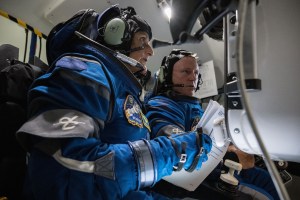
Butch Wilmore: All of it. Yeah, I mean, from start to finish, obviously, it’s an automated spacecraft. That’s the way it’s expected to operate, and we expect it to operate in the automatic mode throughout the entire flight profile. But we’re going to take over and do things manually, test out those capabilities, those downloads. It’s in those downloads that we get rid of some of those black zones we talked about. So, we’re going to do that. And because that’s the capability of the spacecraft, and that’s what makes it such a wonderful spacecraft. She said it’s a—what was the term you used? What was the adjective? It was amazing, or something like that. And it is because of what all the capabilities that it has to affect every aspect of the mission. And also, to preserve human life, which is important. That’s an important aspect of human spaceflight, right?
Suni Williams: Yeah. And I would also say even before the flight, all of the work leading up to this flight has been part of the test pilot dream. You know, flying it, of course is going to be just like the icing on the cake. But, you know, to get to this point, we as a crew, including our backup, Mike Fincke, you know, did a lot of work to make sure we understood how the spacecraft flew, worked with Boeing because they have models. And so we want to make sure that our backup capability, like Butch was mentioning, will do what it’s supposed to do. We actually came up with test programs with some other of our Avengers folks that work with us to make sure we encountered some of these data points and saw where and when and how we could actually manipulate the controls to get to that four-kilometer circle. Such that the point that we were able to work on getting the backup into the guidance system. Getting into a little detail here, but my point is, with all of that, there’s been tons of things and it’s not only just flying, it’s just asking the question, how does the suit in the seat fit? Were there flight test dummies for that beforehand and making sure all of the connections and the hookups and how comfortable it is and how it’s designed. Just asking all those questions are all the things that we’ve learned in test pilot school, is to look at a system, an integrated system, try it out, and then ask the questions about how, why, whatever, what, what can we do? Just thinking about the future crews and making sure everything’s going to be squared away for them.
Host: We’ve talked about several phases of the mission, but let’s talk a little bit about landing. What are your expectations for landing? And just walk us through that process.
Butch Wilmore: That we will land.
[Laughs]
Suni Williams: Softly.
Butch Wilmore: Yes. One of the primary goals. You know, that’s another army of people that are involved with us, as the crew members, that’ll be there to help evaluate us, all types of things when we get back. And also the people that will undertake the spacecraft, right? Checking it out, making sure everything’s good. You know, hypergolics. Hypergols are something that we have on board. Basically, it’s a fuel and an oxidizer, and when they meet, they burn, right? So there’s blast and it’s a controlled explosion in our jets, right? So we have that on board, so they’ll sniff and make sure that there’s no problem with hypergols when we land, and make sure that all the systems are safe before this army of people come in and start effect recovery of us and the spacecraft. And, hopefully we’ll land, White Sands I think is our primary, but we’ve got Wilcox, you won’t know where these places are. Dugway, another one. So, wherever we do land, there’s going to be folks there that, like I said, will take care of us in the spacecrafts.
Suni Williams: Yeah, they’ve practiced a number of times for all sorts of contingencies, but what we are hoping for is three good parachutes, all our airbags, and a nice soft landing. There’s cool animations of it to look at it, and it looks just like it’s landing on a marshmallow as well as we’ve done it twice before, OFT and OFT-2. Both of us have been out to the landing site and watched it and land spot on, you know, the guidance navigation control system brought it right to the center essentially of the four-kilometer circle. And the airbags made it look like it was nice and soft. We didn’t get feedback from Rosie herself, but the data suggests that it will be soft.
Butch Wilmore: Rosie was the flight test dummy.
Suni Williams: We’ll see. We’ll give you words about it when we get back.
Host: We can’t wait to hear about it. You both have talked a lot about the teams behind this mission. Can you just help us to characterize the expansive team that makes this flight possible?
Butch Wilmore: Oh my. How long you got? I mean, there’s people that are involved with rigging the test article for the parachute tests that are huge part of this team. They won’t be with us on launch day or when we get to the desert, but they paved the way with all the parachute tests as one of many examples. The teams that recover us, the teams that launch us, ULA, we were there yesterday morning talking to their teams and all the people that are passionate about their system and making sure that their system is right. You know, the Atlas has RD-180 engines on the bottom of the main lifting and solid rocket boosters on the side when they’re spent. Then you’ve got a centaur, dual engine centaur, that actually lights off. And then you’ve got all the people involved with building those throughout the country.
Suni Williams: Decatur.
Butch Wilmore: Like I said, how long you got it?
Butch Wilmore: And the people designing and working on the hardware, the software designers. The teams and operations with all the folks here at FOD led by our flight directors. I mean, it just goes on and on. And so this is the epitome of teamwork, like we said before. It’s one of those most highly visible team efforts that takes place globally. When you see a rocket launch, there’s a lot that goes into it. You’d see the lights pretty or the fire coming out of the back, and that’s what we see. But there’s thousands of things that have to take place exactly right during a launch evolution that there’s individuals that are responsible for and making sure it goes right.
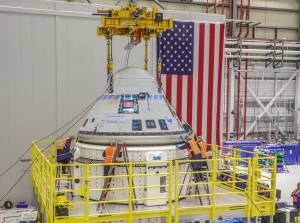
Suni Williams: Yeah. I mean, this spacecraft and modern spacecraft all have a lot of software also, you know, so the software teams as well, and you know, it’s not like they just run a profile or a flight condition once and say, “Oh yeah, it’s good. Check, it’s all done.” You know, there’s some people who have to put in thousands of different commutations of the flight profile because we are launching in and through an atmosphere, and there’s lots of different wind conditions and other conditions that they have to account for. So people who have run thousands and of Monte Carlo runs to make sure that our launch capability, our abort capability, this is a capsule. So, like Dragon and like in the past, we have an abort cap capability right off the pad to know that that is going to work every single time, we did tons of work on that with those guys, you know, it’s a huge undertaking. So there’s tons of people. Thousands of people probably.
Host: Alright, well, in closing, I want to hear from both of you. What are your hopes for future flyers of Starliner?
Butch Wilmore: That they look back and go, “Wow, those guys knew what they were doing.”
[Laughs]
Butch Wilmore: That’s what we do with Apollo. I mean, we look back at Apollo and go, “Wow.” When we try to figure something new out there. Well, these Apollo guys did it this way and, wow, they did it. Smart folks back then, I guess maybe that they don’t have to remember my name, but yeah. Who was that big headed guy? Yeah, that one with the big forehead.
Suni Williams: It’s funny though, because, you know, going through training flows, there’s some things are designed a certain way and you can’t help somebody at some point will ask a question, why did they do that? What was that? And so, it’s funny cause I think in every decision that we’ve been lucky to be a part of, we think about it like in 10 years, will somebody say, “Why did they do that?” And we want to make that why a logical correct reason why we did it as best as we can. So we’ve just tried to do our best thinking about the future and making sure the spacecraft is ready for whoever wants to fly it.
Host: Well, we are certainly proud of you, and I know that they will be as well. We’re going to be cheering you on from here in Houston and all over the world. We’re so happy for you. We’re so proud of you. Thanks for coming on Houston We Have a Podcast.
Butch Wilmore: Thank you.
[Music]
Host: Thanks for sticking around. I hope you enjoyed. Check nasa.gov for the latest on NASA’s Boeing Crew Flight Test. Our full collection of episodes is on nasa.gov/podcasts. You can also find the many other wonderful podcasts we have across the agency. On social media, we’re on the NASA Johnson Space Center pages of Facebook, X, and Instagram. Use #AskNASA on your favorite platform to submit your idea and ask a question, just to make sure to mention it’s for Houston We Have a Podcast.
This episode was recorded March 13, 2024. Thanks to Gary Jordan, Will Flato, Daniel Tohill, Dane Turner, Abby Graf, Jaden Jennings, and Dominique Crespo for their help with the podcast. Thanks to Jerry Swain, Dwight Wright and Tim Terry for their assistance in allowing us to record next to the Starliner simulator here at the Johnson Space Center. Thanks to the astronaut scheduler team, especially Michelle Boisjolie, for giving us time with the crew today. And of course, thanks again to Butch Wilmore and Suni Williams for taking time to come on the show. Give us a rating and feedback on whatever platform you’re listening to us on and tell us what you think of our podcast. We’ll be back next week.
This is an Official NASA Podcast.


























